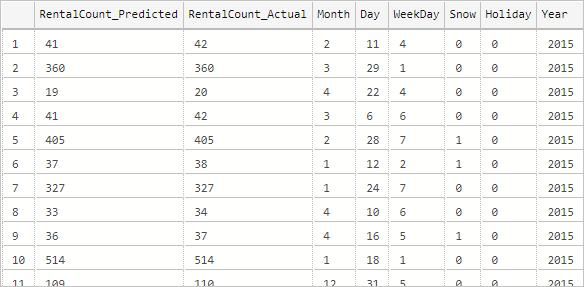適用於:SQL Server 2017 (14.x) 和更新版本
Azure SQL 受控執行個體
在本教學課程系列的第四部分 (總共四個部分) 中,您將使用機器學習服務或巨量資料叢集,將以 Python 開發的線性迴歸模型部署到 SQL Server 資料庫。
在本教學課程系列的第四部分 (總共四個部分) 中,您將使用機器學習服務,將以 Python 開發的線性迴歸模型部署到 SQL Server 資料庫。
在此四部分教學課程的第四部份中,您會使用機器學習服務,將以 Python 開發的線性迴歸模型部署到 Azure SQL 受控執行個體資料庫。
在本文中,您將學會如何:
- 建立會產生機器學習模型的預存程序
- 將模型儲存在資料庫資料表中
- 建立一個使用此模型進行預測的預存程序
- 以新資料執行模型
在第一部分,您已了解如何還原範例資料庫。
在第二部分中,您已了解如何將資料從資料庫載入到 Python 資料框架,並以 Python 準備資料。
在第三部分中,您已了解如何在 Python 中定型線性迴歸機器學習模型。
Prerequisites
- 本教學課程的第四部分會假設您已完成第一部分及其必要條件。
建立一個會產生模型的預存程序
現在,使用您所開發的 Python 指令碼建立預存程序 generate_rental_py_model,以使用 scikit-learn 的 LinearRegression 來定型及產生線性迴歸模型。
在 Azure Data Studio 中執行下列 T-SQL 陳述式,以建立用來定型模型的預存程序。
-- Stored procedure that trains and generates a Python model using the rental_data and a linear regression algorithm
DROP PROCEDURE IF EXISTS generate_rental_py_model;
go
CREATE PROCEDURE generate_rental_py_model (@trained_model varbinary(max) OUTPUT)
AS
BEGIN
EXECUTE sp_execute_external_script
@language = N'Python'
, @script = N'
from sklearn.linear_model import LinearRegression
import pickle
df = rental_train_data
# Get all the columns from the dataframe.
columns = df.columns.tolist()
# Store the variable well be predicting on.
target = "RentalCount"
# Initialize the model class.
lin_model = LinearRegression()
# Fit the model to the training data.
lin_model.fit(df[columns], df[target])
# Before saving the model to the DB table, convert it to a binary object
trained_model = pickle.dumps(lin_model)'
, @input_data_1 = N'select "RentalCount", "Year", "Month", "Day", "WeekDay", "Snow", "Holiday" from dbo.rental_data where Year < 2015'
, @input_data_1_name = N'rental_train_data'
, @params = N'@trained_model varbinary(max) OUTPUT'
, @trained_model = @trained_model OUTPUT;
END;
GO
將模型儲存在資料庫資料表中
在 TutorialDB 資料庫中建立資料表,然後將模型儲存至資料表。
在 Azure Data Studio 中執行下列 T-SQL 陳述式,以建立名為 dbo.rental_py_models 的資料表以用於儲存模型。
USE TutorialDB; DROP TABLE IF EXISTS dbo.rental_py_models; GO CREATE TABLE dbo.rental_py_models ( model_name VARCHAR(30) NOT NULL DEFAULT('default model') PRIMARY KEY, model VARBINARY(MAX) NOT NULL ); GO將模型以二進位物件形式儲存至資料表,並將模型命名為 linear_model。
DECLARE @model VARBINARY(MAX); EXECUTE generate_rental_py_model @model OUTPUT; INSERT INTO rental_py_models (model_name, model) VALUES('linear_model', @model);
建立一個進行預測的預存程序
建立預存程序 py_predict_rentalcount,以使用定型的模型和一組新資料進行預測。 在 Azure Data Studio 中執行下方的 T-SQL。
DROP PROCEDURE IF EXISTS py_predict_rentalcount; GO CREATE PROCEDURE py_predict_rentalcount (@model varchar(100)) AS BEGIN DECLARE @py_model varbinary(max) = (select model from rental_py_models where model_name = @model); EXECUTE sp_execute_external_script @language = N'Python', @script = N' # Import the scikit-learn function to compute error. from sklearn.metrics import mean_squared_error import pickle import pandas rental_model = pickle.loads(py_model) df = rental_score_data # Get all the columns from the dataframe. columns = df.columns.tolist() # Variable you will be predicting on. target = "RentalCount" # Generate the predictions for the test set. lin_predictions = rental_model.predict(df[columns]) print(lin_predictions) # Compute error between the test predictions and the actual values. lin_mse = mean_squared_error(lin_predictions, df[target]) #print(lin_mse) predictions_df = pandas.DataFrame(lin_predictions) OutputDataSet = pandas.concat([predictions_df, df["RentalCount"], df["Month"], df["Day"], df["WeekDay"], df["Snow"], df["Holiday"], df["Year"]], axis=1) ' , @input_data_1 = N'Select "RentalCount", "Year" ,"Month", "Day", "WeekDay", "Snow", "Holiday" from rental_data where Year = 2015' , @input_data_1_name = N'rental_score_data' , @params = N'@py_model varbinary(max)' , @py_model = @py_model with result sets (("RentalCount_Predicted" float, "RentalCount" float, "Month" float,"Day" float,"WeekDay" float,"Snow" float,"Holiday" float, "Year" float)); END; GO建立用以儲存預測的資料表。
DROP TABLE IF EXISTS [dbo].[py_rental_predictions]; GO CREATE TABLE [dbo].[py_rental_predictions]( [RentalCount_Predicted] [int] NULL, [RentalCount_Actual] [int] NULL, [Month] [int] NULL, [Day] [int] NULL, [WeekDay] [int] NULL, [Snow] [int] NULL, [Holiday] [int] NULL, [Year] [int] NULL ) ON [PRIMARY] GO執行預存程序以預測租用次數
--Insert the results of the predictions for test set into a table INSERT INTO py_rental_predictions EXEC py_predict_rentalcount 'linear_model'; -- Select contents of the table SELECT * FROM py_rental_predictions;您應該會看見如下所示的結果。

您已成功建立、定型和部署模型。 接著您在預存程序中使用該模型根據新資料來預測值。
後續步驟
在本教學課程系列的第四部分中,您已完成下列步驟:
- 建立會產生機器學習模型的預存程序
- 將模型儲存在資料庫資料表中
- 建立一個使用此模型進行預測的預存程序
- 以新資料執行模型
若要深入了解如何搭配 SQL 機器學習使用 Python,請參閱: